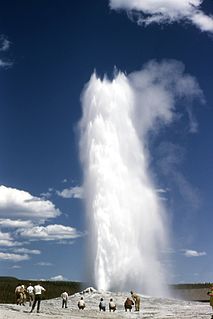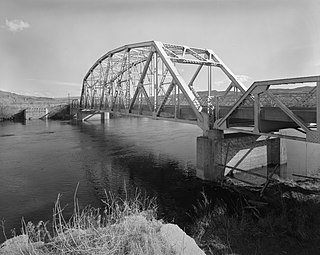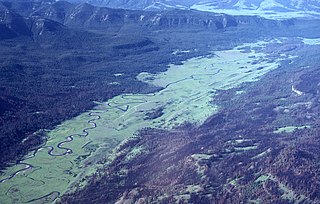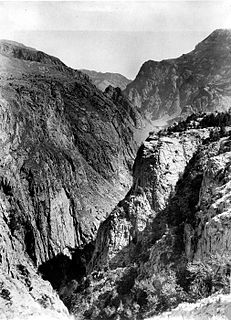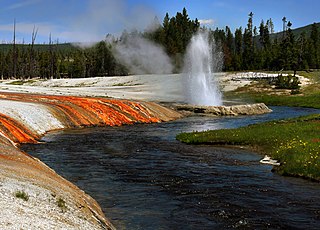| Crawfish Creek | |
| River | |
Bridge across Crawfish Creek, 1989 | |
| Country | United States |
|---|---|
| State | Wyoming |
| Source | |
| - location | 44°10′47″N110°42′08″W / 44.17972°N 110.70222°W [1] , Yellowstone National Park , Wyoming |
| Mouth | |
| - location | Lewis River 44°09′02″N110°40′05″W / 44.15056°N 110.66806°W Coordinates: 44°09′02″N110°40′05″W / 44.15056°N 110.66806°W [1] , Yellowstone National Park , Wyoming |
| - elevation | 6,913 ft (2,107 m) |
Crawfish Creek is a short stream in Yellowstone National Park [2] in the U.S. state of Wyoming [3] This watercourse is known for its unusually warm temperatures compared to other surface water bodies in Wyoming; these elevated temperatures enable crawfish to thrive in the water. Summer water temperatures are in the range of 22 to 24 degrees Celsius; pH levels are typically about 9.1, or somewhat alkaline. [4] The warm waters come from a southern portion of the Yellowstone volcanic zone which produces hot water from hot springs and fumaroles in the area. The stream feeds into the Lewis River just south of the Lewis River Canyon and just before the Lewis River converges with the Snake River.

A stream is a body of water with surface water flowing within the bed and banks of a channel. The stream encompasses surface and groundwater fluxes that respond to geological, geomorphological, hydrological and biotic controls.

Yellowstone National Park is an American national park located in Wyoming, Montana, and Idaho. It was established by the U.S. Congress and signed into law by President Ulysses S. Grant on March 1, 1872. Yellowstone was the first national park in the U.S. and is also widely held to be the first national park in the world. The park is known for its wildlife and its many geothermal features, especially Old Faithful geyser, one of its most popular features. It has many types of ecosystems, but the subalpine forest is the most abundant. It is part of the South Central Rockies forests ecoregion.

In the United States, a state is a constituent political entity, of which there are currently 50. Bound together in a political union, each state holds governmental jurisdiction over a separate and defined geographic territory and shares its sovereignty with the federal government. Due to this shared sovereignty, Americans are citizens both of the federal republic and of the state in which they reside. State citizenship and residency are flexible, and no government approval is required to move between states, except for persons restricted by certain types of court orders. Four states use the term commonwealth rather than state in their full official names.
30 feet (9.1 m) Moose Falls is located 75 yards (69 m) upstream from the Crawfish Creek confluence with the Lewis River.

Moose Falls is a plunge type waterfall on Crawfish Creek in Yellowstone National Park. The waterfall was named in 1885 by members of the Arnold Hague Geologic Survey for the plentiful moose found in the southern sections of the park. The falls are just 75 yards (69 m) west of south entrance road via an easy trail that begins 1.2 miles (1.9 km) north of the south entrance station.
The watershed of Crawfish Creek is densely forested with lodgepole pine, Douglas fir and other tree species.

Pseudotsuga menziesii is an evergreen conifer species in the pine family, Pinaceae. It is native to western North America and is known as Douglas fir, Douglas-fir, Oregon pine, and Columbian pine. There are two varieties: coast Douglas-fir, and Rocky Mountain Douglas-fir.
In biology, a species ( ) is the basic unit of classification and a taxonomic rank of an organism, as well as a unit of biodiversity. A species is often defined as the largest group of organisms in which any two individuals of the appropriate sexes or mating types can produce fertile offspring, typically by sexual reproduction. Other ways of defining species include their karyotype, DNA sequence, morphology, behaviour or ecological niche. In addition, paleontologists use the concept of the chronospecies since fossil reproduction cannot be examined. While these definitions may seem adequate, when looked at more closely they represent problematic species concepts. For example, the boundaries between closely related species become unclear with hybridisation, in a species complex of hundreds of similar microspecies, and in a ring species. Also, among organisms that reproduce only asexually, the concept of a reproductive species breaks down, and each clone is potentially a microspecies.

